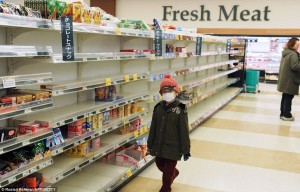【译注】这是一篇[爪译]的翻译文章,原文来自2011-3-14 Medscape的Brendan Borrell,点这里查看英文原文What Will Japanese Near Reactors Face Long-Term? 以下为中英对照译文。
核辐射对日本人的长期影响
 纽约(路透社健康频道)3月14日电-近日福岛核电站氢气爆炸事件发生后,随着日本当局对于这一日益严峻危机的全力以赴,众多当地民众也如临大敌,越来越担心可能的放射线暴露所带来的健康隐患。
纽约(路透社健康频道)3月14日电-近日福岛核电站氢气爆炸事件发生后,随着日本当局对于这一日益严峻危机的全力以赴,众多当地民众也如临大敌,越来越担心可能的放射线暴露所带来的健康隐患。
NEW YORK (Reuters Health) Mar 14 – As the Japanese government grapples with a deepening crisis at the Fukushima Daiichi nuclear plant, Japanese people are increasingly worried about their potential health risks from exposure to radiation.
针对公众的这一担忧,世界卫生组织将日本的公共健康危险评价为“微乎其微”,日本首相菅直人也称“此次事件与切尔诺贝利事故完全不同”。
The World Health Organization has said the public health risk to Japan is “minimal.” Japanese Prime Minister Naoto Kan said “this is fundamentally different from the Chernobyl accident.”
然而直至今日,1986年切尔诺贝利核电站的熔毁事故依然是此类事故中调查最深入、对人类造成影响最广泛的最近发生的核事故。为了对日本在未来若干年后可能面临的健康风险,路透社健康频道特地采访了研究当年切尔诺贝利事故的几位科学家。
Still, the 1986 meltdown at Chernobyl is the best-studied such incident and the most recent nuclear accident that affected a large population. For a look at the health risks Japan could face in the years to come, Reuters Health spoke with scientists who studied the 1986 Chernobyl meltdown.
与当年切尔诺贝利所发生的熔毁、爆炸与火灾相比,日本的此次事件可谓小巫见大巫,因为福岛核电站的放射性物质几乎全部被保留在反应堆内部。目前,福岛事件处于核事故危险7段分级的第4等级,低于1979年美国的三里岛5级事件,而后者并没有造成任何人员伤亡,也并没有对当地的癌症发病率带来影响(切尔诺贝利为7级)。
Unlike the meltdown, explosion, and fires at Chernobyl, radioactivity at Fukushima remains largely contained within the reactor. Currently, Fukushima rates a 4 on the seven-step scale of nuclear incidents, below Three Mile Island in 1979, which rated a 5, resulted in no deaths and had no impact on the incidence of cancer in the region. Chernobyl was a 7.
“切尔诺贝利事件带来的后果中,当地暴露于放射性尘埃的居民,由于甲状腺会摄取放射性的碘,导致了甲状腺癌发病率升高,”来自宾夕法尼亚大学的外科病理学家Virginia LiVolsi博士介绍说,他也同时是切尔诺贝利病理标本库审查小组的成员。一项相关的研究也表明,在白俄罗斯地区由于放射线暴露,导致过去50年中甲状腺癌病例增加了80%。
In the aftermath of Chernobyl, people exposed to radioactive fallout showed higher rates of thyroid cancer because the gland sequesters radioactive iodine, says Dr. Virginia LiVolsi, a surgical pathologist at the University of Pennsylvania, Philadelphia, and a member of the Pathology Review Panel for the Chernobyl Tissue Bank. One study estimated that radiation exposure would raise the number thyroid cancer cases – a rare cancer — in Belarus by 80% over 50 years.
对于造成这一现象的原因,许多科学家认为不能完全归咎于空气中的放射线暴露,罪魁祸首很有可能是当地居民依然饮用来自污染地区的牛奶。日本民众由于平时富含碘的饮食,以及政府发放的碘片,已经得到了很好的保护,使得他们从空气中摄入的放射性碘含量大大减少。
Most scientists attribute the extra risk not to airborne exposure, but to the fact that people kept drinking milk from contaminated areas. The Japanese population is already better protected because of higher levels of dietary iodine, and the government has distributed iodine pills, which will reduce the uptake of radioactive iodine in the air.
可是也不能过于乐观,即便日本可以免去完全熔毁的危险,当地居民也会面临周期性放射性蒸汽的排放,而这一过程仍会持续几个月的时间。
Even if the Japanese can avert a full meltdown, the population will still be faced with periodic venting of radioactive steam, which is expected to last months.
专家表明,相关的危险还是一个未知数,但已经有大量证据表明,长期暴露于低剂量的放射线环境下,包括空气、水与食物等,的确会存在一些危险。切尔诺贝利的相关研究就表明,低剂量的暴露会增加诸如乳腺癌、白血病、早衰(premature aging)、中风与心脏病等的风险。
The related risks are unclear, experts say, but a growing body of evidence shows that long-term exposure to low level radiation in the air, water, and food poses some risk. Chernobyl studies have found that low level exposures can lead to increases in breast cancer, leukemia, premature aging, strokes, and heart attacks.
除此之外,对于出生缺陷人们也十分关注。联合国一份2005年的报告指出,切尔诺贝利事件后没有证据表明存在相关出生缺陷情况的增加。然而到了2010年,来自莫比亚(Mobile)南阿拉巴马大学的Wladimir Wertelecki博士的研究报告说,在受影响地区,诸如先天性脊柱裂或连体婴儿等出生缺陷的比例存在两到三倍的增高。然而,更大规模的综述与政府研究驳斥了这一说法。
There are also concerns about birth defects. A 2005 U.N. report said there was no evidence for an increase in such birth defects following Chernobyl. In 2010, however, Dr. Wladimir Wertelecki, of the University of Southern Alabama in Mobile reported double to triple the normal rate of defects such as spina bifida and conjoined twins – also fairly rare — in affected regions. Still, larger reviews and government studies have played down these risks.
“总的来说,现在尚无有效证据表明低剂量的放射线暴露与疾病之间有明显的关联”,日本长崎大学的流行病学家Vladimir Saenko介绍说,“也许还需要更长期的观察帮助人们增加对这一问题的认识。”
“As a whole, there is no good evidence of a clear link of diseases with exposure to low doses,” says Vladimir Saenko, an epidemiologist at Nagasaki University in Japan, “Perhaps longer observations will help to gain insights into this problem.”
